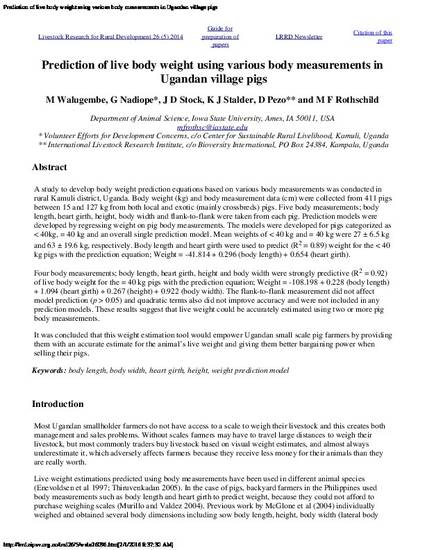
A study to develop body weight prediction equations based on various body measurements was conducted in rural Kamuli district, Uganda. Body weight (kg) and body measurement data (cm) were collected from 411 pigs between 15 and 127 kg from both local and exotic (mainly crossbreds) pigs. Five body measurements; body length, heart girth, height, body width and flank-to-flank were taken from each pig. Prediction models were developed by regressing weight on pig body measurements. The models were developed for pigs categorized as < 40kg, ≥ 40 kg and an overall single prediction model. Mean weights of < 40 kg and ≥ 40 kg were 27 ± 6.5 kg and 63 ± 19.6 kg, respectively. Body length and heart girth were used to predict (R2 = 0.89) weight for the < 40 kg pigs with the prediction equation; Weight = -41.814 + 0.296 (body length) + 0.654 (heart girth).
Four body measurements; body length, heart girth, height and body width were strongly predictive (R2 = 0.92) of live body weight for the ≥ 40 kg pigs with the prediction equation; Weight = -108.198 + 0.228 (body length) + 1.094 (heart girth) + 0.267 (height) + 0.922 (body width). The flank-to-flank measurement did not affect model prediction (p > 0.05) and quadratic terms also did not improve accuracy and were not included in any prediction models. These results suggest that live weight could be accurately estimated using two or more pig body measurements.
It was concluded that this weight estimation tool would empower Ugandan small scale pig farmers by providing them with an accurate estimate for the animal’s live weight and giving them better bargaining power when selling their pigs.
Available at: http://works.bepress.com/max-rothschild/78/

This is an article from Livestock Research for Rural Development 26 (2014): 1. Posted with permission.